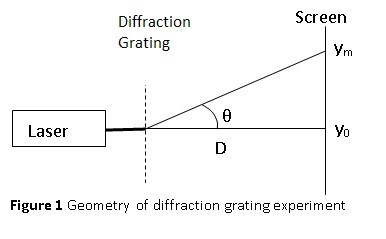

The rainbow glasses I use in this experiment are listed as having 500 lines per mm, which would imply d = 2000 nm (1 mm /500 lines = 0.002 mm see why this is a great lab for unit conversions?). Using the distance between the slits (d) in the diffraction grating as recorded by the manufacturer of the glasses has caused me some trouble in this experiment.
#DIFFRACTION GRATING EXPERIMENT DETERMINE WAVELENGTH HOW TO#
The video below provides a demonstration on how to carry out this experiment and analyze the data.ġ. And there is always the student who measures y in inches and L in meters but doesn’t write down units. This of course leads to spurious results but allows for a teaching opportunity on the importance of paying attention to units. I also note that students will often measure L in meters and y in centimeters – but not convert to consistent units when using Equation 1. Doing this serves the purpose of requiring students to correctly use scientific notation and conversion of metric units (cm to nm) to obtain reasonable results. I give students the value of d = 4.85 x 10 -4 cm, and then have them report to me the wavelength of light in nm. However, it is most often mistakes in unit conversion that gets in the way. Occasionally careless measurement is the culprit. In fact, if students report results that aren’t within 10% of the appropriate wavelength I know something has gone wrong. This experiment generally yields good results. The following relationship exists between the wavelength of light emitted, l, the distance between the slits in the diffraction grating, d, y, and L (see Note 2 for derivation of Equation 1): Notice that we can extend the diffracted beams of light back towards the light source (Figure 2), such that the distance y is the distance between the light source and the image of its next nearest neighbor as viewed through the diffraction grating:įigure 2 - The double blue arrow represents the distance between the light source and its next nearest neighbor as viewed through the diffraction grating. The distance between the light source and diffraction grating is designated L. When light passes through a diffraction grating, some of it gets “bent” from its straight line path (Figure 1):įigure 1 - Light from a red LED (circle on left) passes through a diffraction grating (rainbow glasses). I use rainbow glasses for the diffraction grating. The experiment is based on the diffraction of LED light through a diffraction grating. If you would like to skip reading through the details, scroll down a bit and you will find a video that demonstrates the experimental details and associated data analysis. I use the activity near the beginning of the semester, when students are first learning about measurement, unit conversions, and significant figures. The tracks act as reflecting grating.For a few years now, I have been using a simple laboratory experiment that allows students to calculate the wavelength of various colors of light. Hence, the diffraction takes place after reflection for incident white light to give colourful appearance. On the read/writable side which is polished, there are many narrow circular tracks with widths comparable to the wavelength of visible light.

You would have noticed the colourful appearance of the compact disc. Here, N is the number of rulings per metre in the grating and m is the order of the diffraction image. The wavelength of light is calculated from the equation, Half of its value gives θ, the diffraction angle for first order maximum as shown in Figure 6.67. The difference between two positions gives 2 θ. Similarly the first order diffraction image on the other side is made to coincide with the vertical cross wire and corresponding reading is noted. The reading of the position of the telescope is noted. The telescope is turned to one side until the first order diffraction image of the slit coincides with the vertical cross wire of the eye piece.

The given plane transmission grating is then mounted on the prism table with its plane perpendicular to the incident beam of light coming from the collimator. The telescope is brought in line with collimator to view the image of the slit. The slit of collimator is illuminated by a monochromatic light, whose wavelength is to be determined. Initially all the preliminary adjustments of the spectrometer are made. The wavelength of a spectral line can be very accurately determined with the help of a diffraction grating and a spectrometer. Experiment to determine the wavelength of monochromatic light


 0 kommentar(er)
0 kommentar(er)
